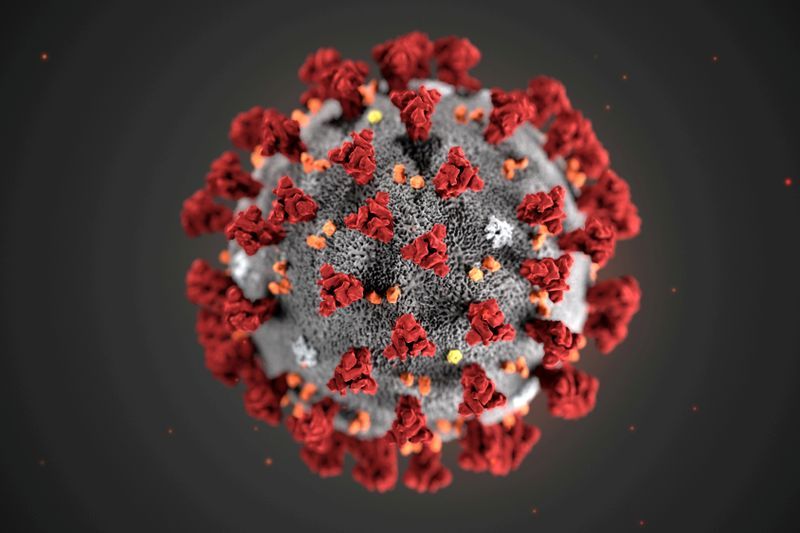Virus more efficient at infection after mutation; diseased lungs more receptive to virus
 FILE PHOTO: An illustration, created at the Centers for Disease Control and Prevention (CDC), depicts the 2019 Novel Coronavirus. REUTERS
FILE PHOTO: An illustration, created at the Centers for Disease Control and Prevention (CDC), depicts the 2019 Novel Coronavirus. REUTERSThe following is a brief roundup of some of the latest scientific studies on the novel coronavirus and efforts to find treatments and vaccines for COVID-19, the illness caused by the virus.
Virus mutation makes it more efficient at entering cells
A genetic mutation in the new coronavirus that significantly increases its ability to infect cells may explain why outbreaks in Northern Italy and New York were larger than ones seen earlier in the pandemic. Scientists at Scripps Research in Florida say the mutated virus was seen infrequently in March, but by April accounted for some 65% of cases submitted from around the world to the GenBank database run by the National Institutes of Health. The mutation, designated D614G, increased the number of “spikes” the virus uses to bind to and break into cells, and made them more stable, researchers found in the study undergoing peer review. In test tube experiments, the mutated virus was roughly 9 times more efficient at breaking into cells and infecting them. “The number – or density – of functional spikes on the virus is 4 or 5 times greater due to this mutation,” said study co-author Hyeryun Choe. It is not clear to what extent the changes affect symptoms and transmission, “but it is hard to believe they do not have some effect,” said Michael Farzan, another lead researcher. “However,” he said, “this particular virus changes slowly, so I wouldn’t expect anything as dramatic as D614G for a while. We don’t expect the virus to become more deadly, just more efficient at propagating itself.” Compared to virus particles without the mutation, the mutated viruses were just as vulnerable to treatment with antibodies from the blood of recovered coronavirus patients, the researchers said.
Diseased lungs more receptive to coronavirus infection
New data helps explain why people with respiratory conditions appear to be more vulnerable to coronavirus infections. The virus breaks into cells via a receptor protein on the cell surface called ACE2. People with conditions like asthma, chronic obstructive pulmonary disease, pulmonary hypertension, and smokers have more of the ACE2 receptors on their lung cells than healthy people do, researchers found. In their analysis of lung cell genes from 700 people with these conditions, they also found that other proteins in addition to ACE2 impacted the “viral life cycle.” This means genes for those proteins “can be potentially important for SARS-CoV-2 cell cycle and invasion/attachment,” they wrote in the Journal of Infectious Diseases. These other genes may also be potential “targets for treating and preventing severe COVID-19 cases,” they said.
Virus has staying power on protective equipment; cotton may be king
A new study highlights the potential risks of handling personal protective equipment (PPE) items after use by front-line healthcare workers. Researchers contaminated eight different types of protective equipment and materials with virus, including nitrile medical examination gloves, reinforced chemical resistant gloves, N-95 and N-100 particulate respirator masks, coveralls made of Tyvek (a textile common in PPE clothing), plastic, cotton, and stainless steel. Under the experimental conditions, potentially contagious virus was still present – although at extremely low levels – after 21 days on a plastic visor, 14 days on stainless steel and Tyvek coveralls, 7 days on nitrile gloves and 4 days on chemical resistant gloves. But only an hour after virus particles were applied to 100% cotton fabric, the amount of active virus had decreased by 99.9%, and it was completely undetectable in less than 24 hours. “These results have direct relevance to infection prevention and control practices, laundering and waste handling protocols in healthcare settings,” the researchers write in a not-yet-peer-reviewed paper posted on Friday on the preprint server medRxiv. “These results suggest that the use of cotton-based fabrics in healthcare settings may present a lower risk during handling for subsequent decontamination and reuse.”
Expert advice to combat sleeping trouble during pandemic
Faced with the health and economic anxiety of life during the coronavirus pandemic, many people are having trouble sleeping. In the journal Behavioral Sleep Medicine on Saturday, the Society of Behavioral Sleep Medicine published a free article with links to two handouts, one for patients and one for doctors. Among the advice for patients: Keep a daily routine; get exposure to sunlight early in the day, preferably outdoors; find ways to socialize by phone or social media (but focus on sharing things that are uplifting or amusing); watch what you eat (and when); and turn off pandemic news coverage a few hours before bed and use the rest of the evening for more relaxing activities. To access the full handouts from the article, click on the “Supplemental Material” link.
SOURCE: REUTERS









